March is National Pet Poison Prevention Month. Here courtesy of Northwest Equine Stewardship Center is a list of the Pacific Northwest “Deadly 7” toxic weeds and plants that livestock owners should learn to recognize and the symptoms they can cause in your animals.
Bracken Fern
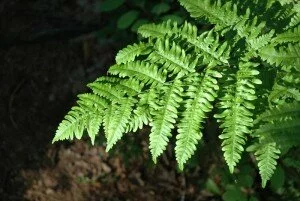
Bracken Fern
The Bracken fern is common to our area. Many varieties of bracken fern are found throughout the U.S., particularly in pastures, meadows, abandoned fields, open woods and may be growing in the fence rows and along roadsides, where animals may browse it when other forage is scarce, like in late summer to early fall. Also, if hay is cut from a bracken fern-infested meadow and fed, poisoning may result.
The bracken fern contains thiaminase, which inhibits absorption of thiamin, which is vitamin B1. Thiamin is necessary for nerve function, and deficiencies can lead to neurological impairment. The relative toxicity of individual leaves is low (horses must consume hundreds of pounds to experience ill effects) however, bracken fern is unique among the toxic plants in that some horses seem to develop a taste for it and will seek it out even when other forages are available.
The first clinical signs of bracken fern poisoning in horses are usually an unsteady gait, a “tucked up” appearance of the flanks, nervousness, timidity, congestion of the visible mucous membranes, and constipation. Signs are related to neural dysfunctions resulting from vitamin B1 deficiency and can include depression, incoordination and blindness. If not treated, death may occur in 2-10 days.
Buttercup
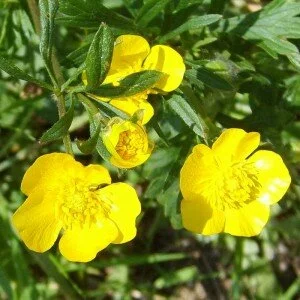
Buttercup
Buttercup is a low-growing, perennial found throughout North America and many other parts of the world. While buttercup is not on the Washington State Noxious Weed List, it is classified as a Weed of Concern in many counties.
Buttercup’s competitive growth crowds out other plants, especially in wet soils. Fresh buttercup plants are toxic to grazing animals, who can suffer from salivation, skin irritation, blisters, abdominal distress, inflammation, and diarrhea. The signs of buttercup poisoning can occur as early as a few hours after ingestion or be delayed up to a day or two, depending on the amount ingested.
Fortunately, buttercup has a strong, bitter taste so animals generally try to avoid it if more palatable forage is available.
Unfortunately, as with the bracken fern, some horses occasionally develop a taste for buttercup and consume fatal quantities. For this reason it is best to keep populations of buttercup under control on grazed pastures and offer plenty of healthy forage.
Foxglove
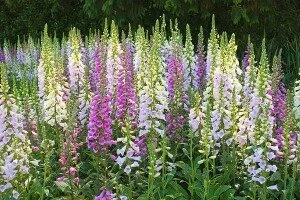
Foxglove
Foxglove is an easily grown plant that prefers moist, acidic soils in part shade. This plant, a biennial, freely self-seeds under favorable growing conditions and can establish colonies in ideal environments that will persist for years as if they were perennials.
Foxglove is a poisonous plant that is possibly fatal if ingested by not only horses, but also cats, dogs and humans. The poisonous ingredient in foxglove is cardio glycosides, which can cause a physical reaction in the heart, nervous system, stomach and intestines of both animals and humans. Cardio glycosides are found in the leaves, flowers and seeds of foxglove. Although, ingestion of this plant can be fatal at any time during the life of the plant, it is most toxic just before the seeds ripen. The upper leaves of the stem are also more toxic than the lower leaves.
Signs of foxglove poisoning generally begin just a few hours after ingestion, and unfortunately most horses are simply found dead. Other early signs include weakness; edema of the head, neck, and eyes; and a slow heart rate that progresses to irregularity. Seizures and inability to rise often occur before death.
If you or your pet has accidentally ingested even a small amount of foxglove, seek immediate medical attention from an emergency veterinarian.
Horsetail
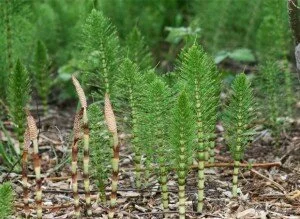
Horsetail
Horsetail is a primitive spore-bearing plant that is native to the Pacific Northwest. Horsetail spreads by spores or creeping rhizomes which can grow to a depth of 6 feet, making control difficult even with herbicides.
Horsetail can have a detrimental effect on horses if it is consumed in large quantities (e.g., 4–5 lbs per day for a 1,000-lb horse, for 1–2 weeks). However the presence of Horsetail in pastures is not a primary concern, as consumption at pasture is usually limited by the plant’s high silicate content and the abundance of other palatable forage options. The ingestion of contaminated hay is where Horsetail can most likely result in poisoning. If horsetail is cut, dried and mixed in with hay in moderate levels, intoxication may occur within 1–4 weeks. Thiaminase, the primary source of toxicity, inhibits absorption of thiamin, vitamin B1, which is necessary for nerve function. Deficiencies can lead to neurological impairment.
Symptoms of Horsetail poisoning are seen primarily in young, rapidly growing horses. The first signs may be a general, scruffy physical appearance, weight loss (without a particular loss of appetite), diarrhea and slightly uncoordinated movements. If not treated, the disease will progress to a point where the horse will show a loss of muscular control, staggering gait and extreme balance issues.
With Horsetail early identification of the symptoms is critical in the treatment. When caught early, the source of Horsetail can be removed, and a full recovery can be expected with appropriate treatment. The best prevention is ensuring Horsetail is not present in your horse’s hay. This makes becoming familiar with the appearance of normal, good-quality hay vital for identifying foreign and potentially dangerous materials easier.
Oak
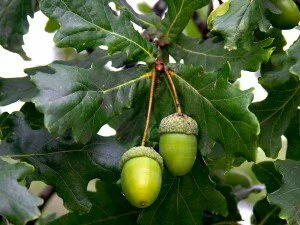
Oak
Oak species are commonly recognized by their leaves, thick bark, and fruit (acorns). Most species of oak contain toxic tannins. Poisoning is caused by young oak browse, sprouts in cutover areas, mature foliage on felled trees, acorns, and fallen leaves. Oak is most dangerous in the budding and leafing stages and when acorns are available however, horses have also been poisoned by drinking water in which oak leaves have soaked. As leaves mature, oak decreases in toxicity.
Plant tannins or their metabolites cause gastrointestinal and renal dysfunction. Symptoms appear several days after the period of consumption and include abdominal pains, weakness, anorexia, colic, constipation, depression, diarrhea, presence of blood in urine, and jaundice. Death from oak poisoning may occur in a few days to 2 weeks after the first signs.
Poisoning by oak is usually seasonal, being most common in spring when the young buds or leaves are eaten and the autumn when the acorns or dried leaves are eaten. While ingesting a small number of leaves or acorns is almost certainly harmless, they can also be addictive, and once a horse has acquired a taste for them they can actively search them out.
Rhododendron
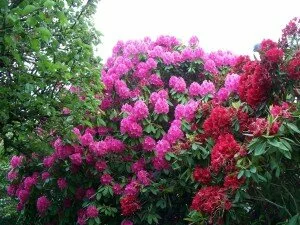
Rhododendron
Rhododendron is a genus of a shrub with about 800 species worldwide. All parts of the plant, but especially the foliage, contains toxic resins (andromedotoxins, now commonly referred to as grayanotoxin), and two or three leaves may produce severe toxicosis. Because Rhododendrons are more likely to retain green leaves year round than are most other plants, most toxicoses occur in the winter and early spring, when other forage is unavailable.
Grayanotoxin produces gastrointestinal irritation with some hemorrhage, secondary aspiration pneumonia, and sometimes renal tubular damage and mild liver degeneration. Signs of poisoning usually appear within six hours of ingestion. Affected animals may experience anorexia, depression, acute digestive upset, hypersalivation, nasal discharge, epiphora, projectile vomiting, frequent defecation, and repeated attempts to swallow. There also may be weakness, incoordination, paralysis of the limbs, stupor, and depression. Animals may remain sick for more than 2 days and gradually recover or death may occur (note: goats are particularly prone to rhododendron toxicity since they will often eat it if given the chance and it doesn’t take much to be deadly).
Tansy Ragwort

Tansy Ragwort
Tansy ragwort, along with common groundsel and fiddleneck, are commonly found weeds in Western Washington and are extremely toxic to horses due to their content of toxins called pyrrolizidine alkaloids (PAs).
Repeated exposure to PA-containing plants in hay, alfalfa pellets or silage results in chronic liver failure, poor-doing and non-productive animals, and, eventually, death. Clinical signs often do not occur until many months after cessation of exposure to PAs and diagnosis of poisoning can be difficult.
There is no effective treatment for affected animals, so preventing exposure is essential. Based upon the insidious and cumulative nature of the poisoning, there is no safe consumption level. Pyrrolizidine alkaloids (PAs) are potent liver toxins which result in loss of liver cell function, chronic damage to the liver and ultimately liver failure.
While ingestion of very high concentrations of PAs can result in rapid and significant liver damage, the more typical problem is exposure to lower concentrations of PAs over time which results in chronic liver damage. In horses, the onset of clinical signs is often sudden and associated with a build-up of waste products normally eliminated by the liver.
Signs generally aren’t present until the liver has failed and are typically neurologic. Signs generally develop after a total ingestion of 50 lbs to 150 lbs, or about 1 to 5 percent of a horse’s body weight, for several weeks, and include head pressing, aimless walking or pacing, persistent chewing, yawning, drowsiness, rectal straining and incoordination. Other signs include fluid build-up in the abdomen, diarrhea or constipation.
For More Information:
Western Washington Poisonous Plants (PDF)




Thanks. Great article.